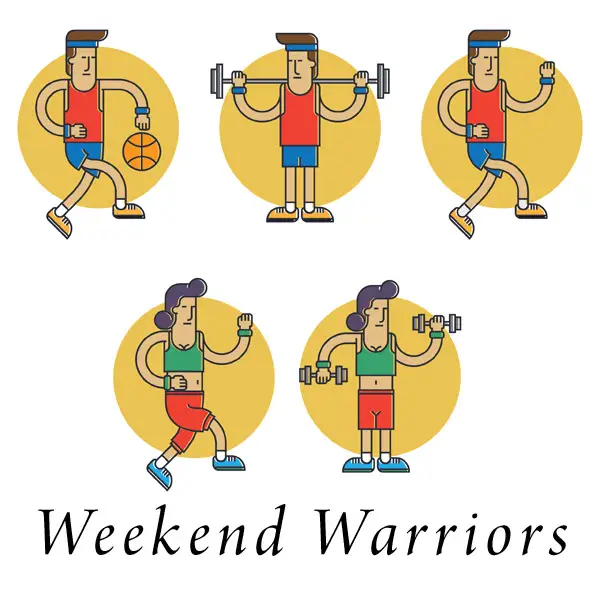
For Pain Relief, Can No Exercise Be Better than Some Exercise?
Many of us have steady employment responsibilities that occupy our time from the break of dawn to late into the evening. Yet more of us have obligations the moment we set foot into the front door taking care of children, spouses, or pets; answering that email we forgot to answer; replying to the last 15 text messages we missed (LOL), or calling back our distant relative who picked that particular day to ‘catch up on lost time.’ So what is a 30-something, formerly active, contributing member of society to do for exercise?
Many people, through no fault, refuse to give up on the days when those high school pants fit and carve out what little time is left in the week to try and make up on lost exercise. Warning! If this is describing you-you may be at risk of being a Weekend Warrior (Gasp)! Weekend Warriors may be defined loosely as ‘exercising vigorously only once a week or less’ which may actually increase your risk of an injury.
Weekend warriors can be men or women, young or old. Most commonly, this pattern of behavior affects formerly active people over the age of 30 whose work and family obligations prevent regular exercise throughout the week. Thus, said Warrior’s resort to increasing the intensity of the workouts and reducing the time with the goal of burning maximum calories or building maximum muscle in the briefest time possible.
Such a sporadic, irregular pattern of behavior predisposes Warriors to muscle strain, plantar fasciitis, tendinitis, or even Achilles tendon tear – all of which may be serious enough to require medical attention.
Achilles tendon rupture: The onset of Achilles tendinitis is usually acute, often running with sudden stops and starts, improper stretching prior to vigorous activity, or improper stretching of the gastrocnemius muscle before exercise. The pain of Achilles tendinitis or rupture is localized to the posterior ankle. Pain is induced with resisted plantar flexion of the foot (pointing your toes); MRI is the imaging modality of choice to characterize if a rupture is present. For tendinitis initial treatment is NSAIDs, and physical therapy, and avoidance of strenuous exercise for some time (1)(2).
Plantar fasciitis: Plantar fasciitis is characterized by pain and tenderness over the plantar surface of the calcaneus (ankle). Plantar fasciitis is often more common in women than men and believed to be due to inflammation of the plantar fascia along the bottom of the foot. High impact aerobic exercise may be one of the causative factors. Patients demonstrate tenderness along the plantar fascia and are increased with dorsiflexion of the toes. NSAIDs and physical therapy are mainstays for the treatment of plantar fasciitis as well as avoiding repetitive activities that irritate the fascia (3)(2).
Muscle strain: Muscle strain or tear refers to damage to a muscle/tendon. This is often a sequelae of sudden heavy lifting, running, or excessive exercise without appropriate endurance training or with improper technique. It also may occur due to poor flexibility or fatigue. If the strain or tear is severe enough, the tearing of muscle can also damage small blood vessels causing local bleeding and bruising in the area and pain. Rest, ice, and elevation are treatment modalities of choice for muscle strain, in addition to NSAIDs to reduce inflammation. A muscle strain may be characterized by sudden onset of pain, soreness, limited range of motion, swelling, or muscle stiffness/spasm (4).
Ever heard the adage, “Rome was not built in a day”? Unfortunately, many people hurt themselves when they adopt an intensive exercise program despite being relatively inactive and poorly conditioned. Thinking about training for that upcoming marathon? Not so fast. Literally.
The most common mistake is attempting to do too much and too fast. The injury is most likely with the first few, sporadic workouts causing the untoward consequence of having to undergo relative rest to heal from the injury. Thousands of Americans daily visit the emergency room for sports and exercise-related injuries as published by the CDC. To avoid the painful saunter into the ER, a better plan is to engage in shorter, more frequent, less intense (initially) exercise sessions gradually increasing the time and intensity of the workout, and consistency!
Although some exercise is always better than no exercise, spreading your workout over several days minimizes fatigue, builds endurance, and may ultimately reduce the risk of injury.
Follow these pearls for avoiding weekend-warrior injuries:
- Do a warm-up. Stretch after your muscles are warmed up.
- Sore muscles are normal after an intense workout, but if you feel sharp or stabbing pain, stop exercising immediately.
- Find an accountability partner. You’ll also be more likely to exercise regularly.
- Use proper technique when you’re working out. If you are unsure, consider hiring a trainer.
(1) Waldman, SD: The Achilles tendon. In Pain review, Philadelphia, 2009, Saunders, p. 161.
(2) Waldman, Steven D. Atlas of Common Pain Syndromes. Philadelphia: Elsevier, 2012. Print.
(3) Rajput B, Abboud RJ: Common ignorance, major problem: the role of footwear in plantar fasciitis, Foot 14(4): 214-218, 2004.
(4) Noonan TJ, Garrett WE. “Muscle strain injury: diagnosis and treatment,” Journal of the American Academy of Orthopaedic Surgeons, 7(4), Jul-Aug 1999, pp 262-9.
Recent Posts
How the Right Foods Help Ease Chronic Pain
November 26, 2024Workplace Pain Relief and Management: The Best Ways to Diminish Pain
February 12, 2020Knee Pain — Healing for Health and Happiness, Capitol Pain
December 12, 2019Share this Post
